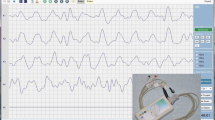Abstract
Cutaneous recordings of gastric electrical activity (electrogastrography (EGG)) could become a valuable non-invasive tool for recognising gastric electrical abnormalities. Although signals obtained with internally implanted electrodes deliver quantitative information, this technique cannot be used for diagnostic purposes because of its invasive nature. On the other hand, the objectivity of electrogastrography is still in question. The aims of this work are to develop computer techniques for extracting quantitative information from digital electrogastrograms, and to evaluate quantitatively EGG recordings from healthy volunteers. The dynamics of all four EGG parameters are studied: amplitude, frequency, time shift between different channels, and waveform. Four separate two-dimensional computer plots are developed using specially designed digital signal-processing procedures. Each parameter is evaluated in a study of 20 healthy volunteers. Frequency is found to be the only EGG parameter that shows quantitative consistency and merit.
Similar content being viewed by others
References
Abell, T. L., andMalagelada, J.-R. (1988): ‘Electrogastrography: current assessment and future perspectives’,Dig. Dis. Sci.,33, pp. 982–992
Alvarez, W. C. (1922): ‘The electrogastrogram and what it shows’,JAMA, 78,(15), pp. 1116–18
Bracewell, R. N. (1986): ‘The Hartley transform’ (Oxford University Press, New York)
Chen, J., andMcCallum, R. W. (1991): ‘Electrogastrography: measurement, analysis and prospective applications’,Med. Biol. Eng. Comput.,29, pp. 339–50
Chen, J., Vandewalle, J., Sansen, W., Van Cutsem, E., Vantrappen, G., andJanssens, J. (1989): ‘Observation of the propagation direction of human electrogastric activity from cutaneous recordings’,Med. Biol. Eng. Comput.,27, pp. 538–542
Code, C. F., andMarlett, J. A. (1975): ‘The interdigestive myoelectrical complex of the stomach and small bowel of dogs’,J. Physiol.,246, pp. 289–309
Daniel, E. E., andChapman, K. M. (1963): ‘Electrical activity of gastrointestinal tract as an indicator of mechanical activity’,Am. J. Dig. Dis.,54, pp. 54–102
Familoni, B. O., Bowes, K. L., Kingma, Y. J., andCote, K. R. (1991): ‘Can transcutaneous recordings detect gastric electrical abnormalities?’Gut,32, pp. 141–146
Familoni, B. O., Kingma, Y. J., andBowes, K. L. (1987): ‘Study of transcutaneous and intraluminal measurement of gastric electrical activity in humans’,Med. Biol. Eng. Comput.,25, pp. 397–402
Geldof, H., Van der Schee, E. J., andGrashuis, J. L. (1986): ‘Electrogastrographic characteristics of the interdigestive migrating complex in man’,Am. J. Physiol.,250, pp. G165-G171
Hamilton, J. W., Bellahsene, B. E., Reichelder, M., Webster, J. G., andBass, P. (1986): ‘Human electrogastrograms: comparison of surface and mucosal recordings’,Dig. Dis. Sci.,31, pp. 33–39
Kingma, Y. J. (1989): ‘The electrogastrogram and its analysis’,C R C Crit. Rev. Biomed. Eng.,17, (2), pp. 105–124
Kingma, Y. J., Chambers, M. M., Bowes, K. L., andBannister, C. (1981): ‘Interpretation of computer processed electrical signals from the gastro-intestinal tract.’ Proc. 14th Hawaii Int. Conf. on System Sciences, Honolulu, Hawaii
Mintchev, M. P., andBowes, K. L. (1994): ‘Capabilities and limitations of electrogastrograms’in Chen, J., andMcCallum, R. W. (eds.): ‘Electrogastrography—principles and applications’ pp. 155–169
Mintchev, M. P., Kingma, Y. J., and Bowes, K. L. (1991): ‘Use of autocorrelation to improve the three dimensional plot of transcutaneous human electrogastrograms’in:Nagel, J. H. and Smith, W. M. (Eds.): ‘Proc. 13th Ann. IEEE Int. Conf. on Biomedical Engineering,13,pp. 490–49
Mintchev, M. P., Kingma, Y. J., andBowes, K. L. (1993): ‘Accuracy of cutaneous recordings of gastric electrical activity’,Gastroenterol. 104, pp. 1273–1280
Oppenheim, A. V., andSchafer, R. W. (1975): ‘Digital signal processing’ (Prentice-Hall, New Jersey)
Smout, A. J. P. M (1980): ‘Myoelectric activity of the stomach. Gastroelectromyography and electrogastrography’ (Delft University Press, Delft, The Netherlands.)
Smout, A. J. P. M., Van der Schee, E. J., andGrashuis, J. L. (1980): ‘What is measured in electrogastrography?’Dig. Dis. Sci.,25, pp. 179–188
Szurszewski, J. H. (1981): ‘Electrical basis for gastrointestinal motility’in Johnson, L. R. (Ed.): ‘Physiology of the gastrointestinal tract, Vol 2’ (Raven Press, New York) pp.1435–1466
Van der Schee, E. J., andGrashuis, J. L. (1987): ‘Running spectrum analysis as an aid in the representation and interpretation of electrogastrographic signals’,Med. Biol. Eng. Comput.,25, pp. 57–62
Author information
Authors and Affiliations
Rights and permissions
About this article
Cite this article
Mintchey, M.P., Bowes, K.L. Extracting quantitative information from digital electrogastrograms. Med. Biol. Eng. Comput. 34, 244–248 (1996). https://doi.org/10.1007/BF02520081
Received:
Accepted:
Issue Date:
DOI: https://doi.org/10.1007/BF02520081




